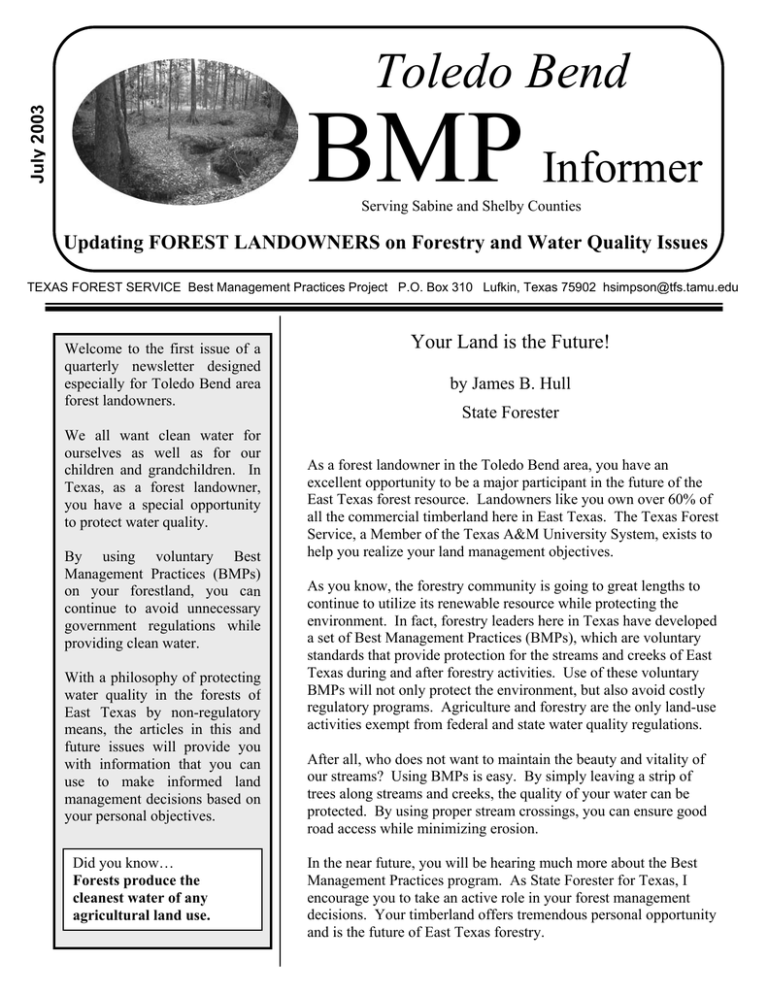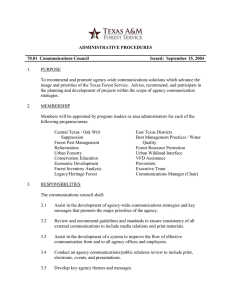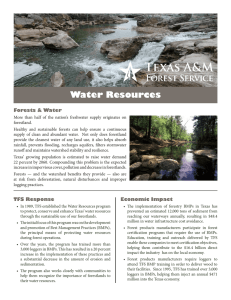BMP Toledo Bend Informer Updating FOREST LANDOWNERS on Forestry and Water Quality Issues
advertisement

Toledo Bend July 2003 BMP Informer Serving Sabine and Shelby Counties Updating FOREST LANDOWNERS on Forestry and Water Quality Issues TEXAS FOREST SERVICE Best Management Practices Project P.O. Box 310 Lufkin, Texas 75902 hsimpson@tfs.tamu.edu Welcome to the first issue of a quarterly newsletter designed especially for Toledo Bend area forest landowners. We all want clean water for ourselves as well as for our children and grandchildren. In Texas, as a forest landowner, you have a special opportunity to protect water quality. By using voluntary Best Management Practices (BMPs) on your forestland, you can continue to avoid unnecessary government regulations while providing clean water. With a philosophy of protecting water quality in the forests of East Texas by non-regulatory means, the articles in this and future issues will provide you with information that you can use to make informed land management decisions based on your personal objectives. Did you know… Forests produce the cleanest water of any agricultural land use. Your Land is the Future! by James B. Hull State Forester As a forest landowner in the Toledo Bend area, you have an excellent opportunity to be a major participant in the future of the East Texas forest resource. Landowners like you own over 60% of all the commercial timberland here in East Texas. The Texas Forest Service, a Member of the Texas A&M University System, exists to help you realize your land management objectives. As you know, the forestry community is going to great lengths to continue to utilize its renewable resource while protecting the environment. In fact, forestry leaders here in Texas have developed a set of Best Management Practices (BMPs), which are voluntary standards that provide protection for the streams and creeks of East Texas during and after forestry activities. Use of these voluntary BMPs will not only protect the environment, but also avoid costly regulatory programs. Agriculture and forestry are the only land-use activities exempt from federal and state water quality regulations. After all, who does not want to maintain the beauty and vitality of our streams? Using BMPs is easy. By simply leaving a strip of trees along streams and creeks, the quality of your water can be protected. By using proper stream crossings, you can ensure good road access while minimizing erosion. In the near future, you will be hearing much more about the Best Management Practices program. As State Forester for Texas, I encourage you to take an active role in your forest management decisions. Your timberland offers tremendous personal opportunity and is the future of East Texas forestry. TEXAS FOREST SERVICE Certified Forest Steward The Certified Forest Steward program identifies landowners who follow a written Stewardship plan. Once you have a Stewardship plan, you can request certification or be nominated by a local resource professional, consultant, or county agent. All TFS district offices have the nomination forms. Nomination forms and an overview of the program can also be obtained on the TFS website: http://texasforestservice.tamu.edu/s hared/article.asp?DocumentID=47 2&mc=forest. The form requires a list of your Stewardship practices that have been installed in the last five years plus a copy of your Stewardship plan. Each accomplishment will be awarded points based on importance to proper land management. For example, a thinning using BMPs to improve a timber stand is worth more points than fencing to manage woods grazing. Any practice that has the potential to affect water quality must use BMPs. If you qualify, you will be presented a “Forest Stewardship” sign for your property and a certificate at a public ceremony of your choice. For more information about obtaining your own Stewardship plan and becoming a Certified Forest Steward, contact your local TFS district office or TFS Stewardship Coordinator Brad Barber at (979) 458-6650 or bbarber@tfs.tamu.edu. Improving My Land Streamside Management Zones A great way to improve and protect your forestland is by creating a Streamside Management Zone, or SMZ. An SMZ is a protective buffer of vegetation along a stream or creek. As a general rule of thumb a 50-foot buffer of trees on both sides of the stream is usually sufficient for protecting water quality. Streamside Management Zones are easily visible in this photo. SMZs help improve your land by: • Reducing the amount of sediment or dirt that may get into a stream • Providing shade to maintain a consistent water temperature for the fish and the insects that they eat • Stabilizing stream banks and protecting them from erosion • Providing habitat and travel corridors for wildlife. Don’t forget that you can harvest (thin) in an SMZ and still be within the voluntary guidelines. Just leave 50% of the shade for a distance of 50 feet from the bank on both sides. Ask your logging contractor or other forestry professional about SMZs. Your land will benefit in many ways and you can show your commitment to being a good “Land Steward.” TEXAS FOREST SERVICE What is a Watershed? A watershed is an area of land that drains rainfall into a stream or lake. They are generally named for the water body that is at the end, or downhill, portion of the area being considered. Watersheds vary considerably in size. However a small stream on your property may drain only a hundred acres. Keep in mind that your small stream flows into a larger stream that would be part of an even larger watershed such as the Sabine River. While forested watersheds provide the highest quality water, some forestry activities have the potential to lead to erosion. The use of Best Management Practices keeps the soil in place in the watershed, preventing siltation into streams. The figure to the right depicts a three-dimensional watershed with its associated streams. An ephemeral stream, sometimes called a drain or swag, carries water only during and for a short time after a rain. An ephemeral stream may or may not have a well-defined channel. An intermittent stream carries water at least 30%, or about four months, of the year continuously, but not year-round. Intermittent streams have welldefined channels with scoured bottoms, a result of the flow. A perennial stream flows yearround, but may pool during drought conditions. Ephemeral Stream Intermittent Stream Perennial Stream Watershed Boundary These distinctions become important when deciding where Streamside Management Zones are recommended. As a general guideline, SMZs should be used along intermittent and perennial streams. These are the recommended minimum voluntary guidelines. Your common sense should guide your final determination. Toledo Bend is located within the Toledo Bend Reservoir watershed. Also included within this watershed are the Sabine River, Brittain Creek, Sanders Creek, Pauls Creek, Grannies Creek, Reeves Creek, Mason Creek, Clear Creek, Bull Creek, Indian Creek, and Beef Creek, among others. This watershed drains a total of 2,390 square miles. You can find much more information about your watershed by visiting the Environmental Protection Agency’s (EPA) World Wide Web page at http://www.epa.gov/surf. Another good source of information on the Toledo Bend Reservoir watershed is the Environmental Statistics Group site at http://www.esg.montana.edu/gl/huc/12010004.html . TEXAS FOREST SERVICE Distribution of the Lake Livingston BMP Informer is provided free of charge to forest landowners of Sabine and Shelby Counties. Funding has been provided through cooperation of the Environmental Protection Agency (EPA), the Texas State Soil & Water Conservation Board (TSSWCB) and the Texas Forest Service (TFS). PLEASE ADVISE US IF YOU WISH YOUR NAME REMOVED FROM OUR MAILING LIST. The Texas Forest Service is An Affirmative Action/Equal Opportunity Employer Committed to Excellence through Diversity. TDD Line: 866-419-4872 Texas Forest Service District Offices Serving You Center San Augustine (Shelby County) (San Augustine and Sabine Counties) John Warner—District Forester (936) 598-2192 jwarner@tfs.tamu.edu 1110 Tenaha St. P. O. Box 968 Center, TX 75935-0968 Jeff Howell—District Forester (936) 275-3438 jhowell@tfs.tamu.edu Highway 147 South Rt. 5 Box 1100 San Augustine, TX 75972-9100


